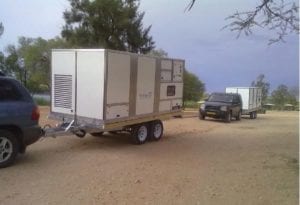Leading up to the 2014 WISA Conference, IMIESA caught up with the NuWater team to discuss their ‘Water on Wheels’ concept and how this is helping to address South Africa’s growing water treatment challenges.
ACCORDING TO John Holmes, NuWater CEO, “As demand for safe, high-quality water overwhelms existing water infrastructure, the need for innovative solutions and technology has never been greater. Large infrastructure projects simply take too long to deliver to have the sort of immediate impact that is required to address the gap between demand and available water treatment capacity. NuWater therefore focuses a lot of its resources on decentralised solutions that address the immediate requirements of communities or businesses. This is where NuWater’s range of modular, rapidly deployable, and re-deployable plants have the greatest and most immediate impact. “Depending on the specific application the wheels part of the concept may not be critical but the ‘water’ part always is. The ‘Water on Wheels’ concept does however convey this idea that water treatment plants, and for that matter, wastewater treatment plants, can be rapidly deployed almost anywhere and with minimal fixed infrastructure. It also indicates the flexibility of our solutions that are capable of addressing both short- and long-term requirements. It is all about speed of deployment and flexible re-deployment of treatment capacity. Of course NuWater still targets more conventional water and wastewater treatment infrastructure where we also have an impressive track record. Even for large centralised water treatment plants we are seeing the benefits of recycling our ‘Water on Wheels’ designs to achieve more compact, flexible and efficient plants.” Does the concept work in practice and is it scalable?Jeeten Nathoo, head of technology, explains, “NuWater has had the benefit of designing, building, financing and operating the largest rapidly re-deployable water treatment and desalination plant in the world. This plant has been successfully operating at Anglo American Thermal Coal’s New Vaal Colliery near Vereeniging for the past three years and has to date treated over 12 billion litres of mine wastewater to near potable standard – the water is in fact used as high quality cooling water for Eskom’s Lethabo power station. The plant is capable of treating and desalinating up to 20 million litres per day – that’s the equivalent of the average daily water consumption of around 300 000 people.” He continues, “This plant is completely modular and mobile. Its modularity means that its capacity can be easily scaled up or down to address changes in the mine’s water treatment requirements. The customer really appreciates this flexibility.” Holmes adds, “Even more than the flexibility, Anglo was really pleased to see us ‘put our money where our mouth is’ by funding the entire plant and charging for the service provided rather than them having to pay for the plant up front. This approach removed the technical and financial risk for Anglo and has allowed us to build a close customer relationship with them as our interests are fully aligned. We have a number of similar plants operating on the same basis for example in Ghana.”
“NuWater’s intimate involvement in each step, from the underlying technology development, through the engineering design and build, and then the financing and operation of such large-scale modular plants and we have designed, built and sold a number of these both in South Africa and other parts of sub-Saharan Africa. We have developed and refined a range of water treatment and desalination plants starting from a capacity of around 50 m3 per day – for example, 50 m3 /day, 100 m3/day and 250 m3. We are now working with strategic partners to roll these smaller ‘package plants’ out to address the requirements of smaller urban and rural communities across sub-Saharan Africa.”
Water treatment is typically an energy-intensive process. How does NuWater address the power requirements for these types of distributed package plants?According to Nathoo, NuWater is tackling the power challenge from three directions: firstly, looking at how power consumption of its plants can be reduced, secondly, at what reliable power generation options are available from trusted partners with a similar view on distributed infrastructure, and thirdly, what alternative energy options exist in the specific location or environment where the plant is being operated. “The starting point has to be more energyefficient technologies, plant designs and operating regimes. NuWater has a number of innovations either being tested or being commercially piloted – these innovations are now feeding through into our more energyefficient plants. Innovations span different parts of the water treatment process and include ceramic filtration membranes, lowpressure reverse osmosis, energy recovery devices and high water recovery technology.”He concedes that there is no silver bullet when it comes to energy usage and water treatment so improvements will generally be incremental in nature. “In terms of power supply, grid electricity, where it is available and in sufficient quantities, tends to be the most cost-effective option. NuWater maintains strategic relationships with providers of diesel power generation solutions ranging from small to large, which offer a reliable but still costly alternative. However, in combination with our energyefficient technologies we are very excited about renewables and alternative energy solutions in combination with our water and wastewater treatment technologies. We expect to have a number of solarpowered plants deployed by the end of year. We are also working with Citius Energy (www.citiusenergy.com) to develop larger-scale water and wastewater treatment projects powered by feedstock such as municipal waste, biomass and coal fines.” So where does NuWater think we are in the adoption cycle for these new concepts?
Holmes sums it up succinctly, “We’re just beginning but adoption is accelerating. Market growth in the next few years is going to be very exciting.”








